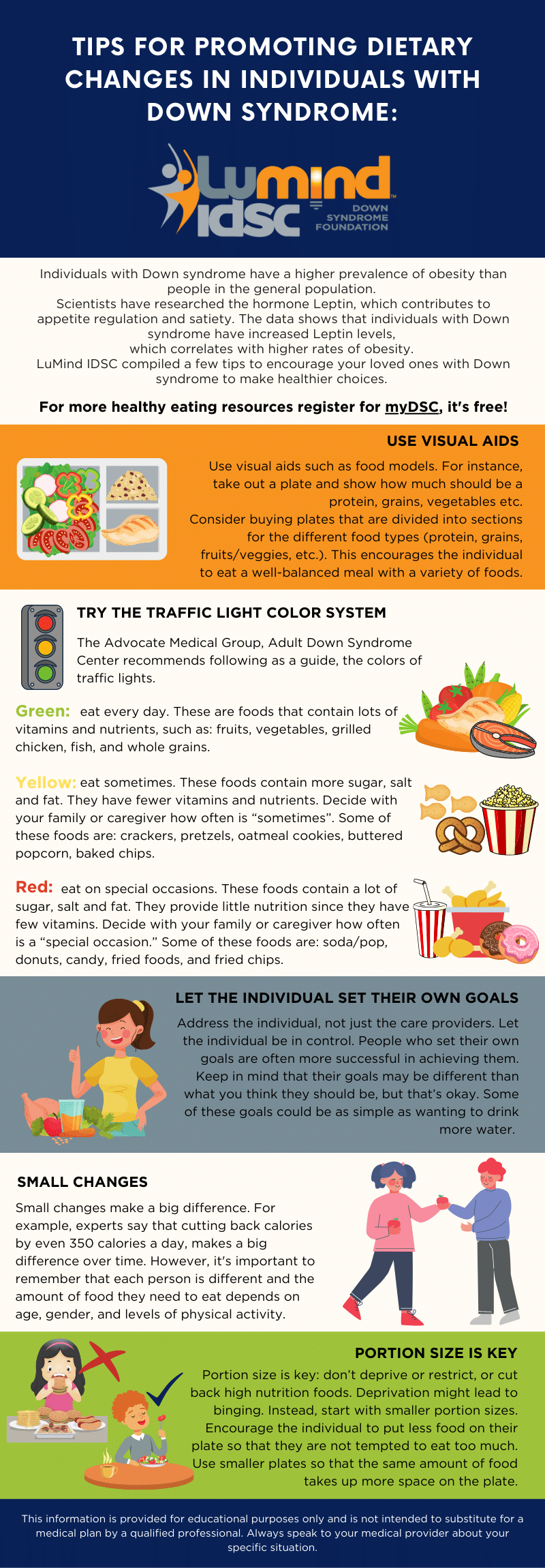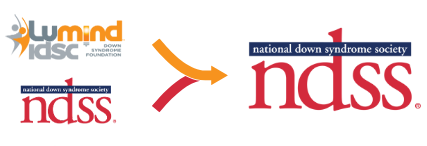Having a healthy and well-balanced diet has many benefits. Experts recommend eating healthy foods to prevent chronic diseases. In an earlier blog post, we shared that “Researchers are also learning about lifestyle changes that can lower the risk of Alzheimer’s disease. These include diet and exercise to maintain a healthy weight.” Since we know that people with Down syndrome have a higher risk of obesity and developing Alzheimer’s disease, it’s important to act and promote healthier lifestyles considering prevention.
Although a person’s journey into healthy eating is a personal and highly individualized experience, there are a few things that we can do to help our loved ones with Down syndrome to achieve those goals, such as supporting them in an understanding and compassionate way. LuMind IDSC compiled a few tips to encourage individuals with Down syndrome to make healthier choices.
This article is not intended to substitute your primary care provider’s recommendations on your own individual case. For more ideas, webinars from Down syndrome experts, and social stories to help guide your loved ones, join myDSC, it’s free!
This article is not intended to substitute your primary care provider’s recommendations on your own individual case. For more ideas, webinars from Down syndrome experts, and social stories to help guide your loved ones, join myDSC, it’s free!
Use visual aids: Use visual aids such as food models. For instance, take out a plate and show how much should be a protein, grains, vegetables etc. Consider buying plates that are divided into sections for the different food types (protein, grains, fruits/veggies, etc.). This encourages the individual to eat a well-balanced meal with a variety of foods.
Try the traffic light color system: The Advocate Medical Group, Adult Down Syndrome Center recommends following as a guide, the colors of traffic lights.
- Green: eat every day. These are foods that contain lots of vitamins and nutrients, such as: fruits, vegetables, grilled chicken, fish, and whole grains.
- Yellow: eat sometimes. These foods contain more sugar, salt and fat. They have fewer vitamins and nutrients. Decide with your family or caregiver how often is “sometimes”. Some of these foods are: crackers, pretzels, oatmeal cookies, buttered popcorn, baked chips.
- Red: eat on special occasions. These foods contain a lot of sugar, salt and fat. They provide little nutrition since they have few vitamins. Decide with your family or caregiver how often
is a “special occasion.” Some of these foods are: soda/pop, donuts, candy, fried foods, and fried chips.
Let the individual set their own goals: Address the individual, not just the care providers. Let the individual be in control. People who set their own goals are often more successful in achieving them. Keep in mind that their goals may be different than what you think they should be, but that’s okay. Some of these goals could be as simple as wanting to drink more water.
Make small changes: Small changes make a big difference. For example, experts say that cutting back calories by even 350 calories a day, makes a big difference over time. However, it’s important to remember that each person is different and the amount of food they need to eat depends on age, gender, and levels of physical activity.
Portion size is key: Portion size is key: don’t deprive or restrict, or cutback high nutrition foods. Deprivation might lead to binging. Instead, start with smaller portion sizes. Encourage the individual to put less food on their plate so that they are not tempted to eat too much. Use smaller plates so that the same amount of food takes up more space on the plate.

